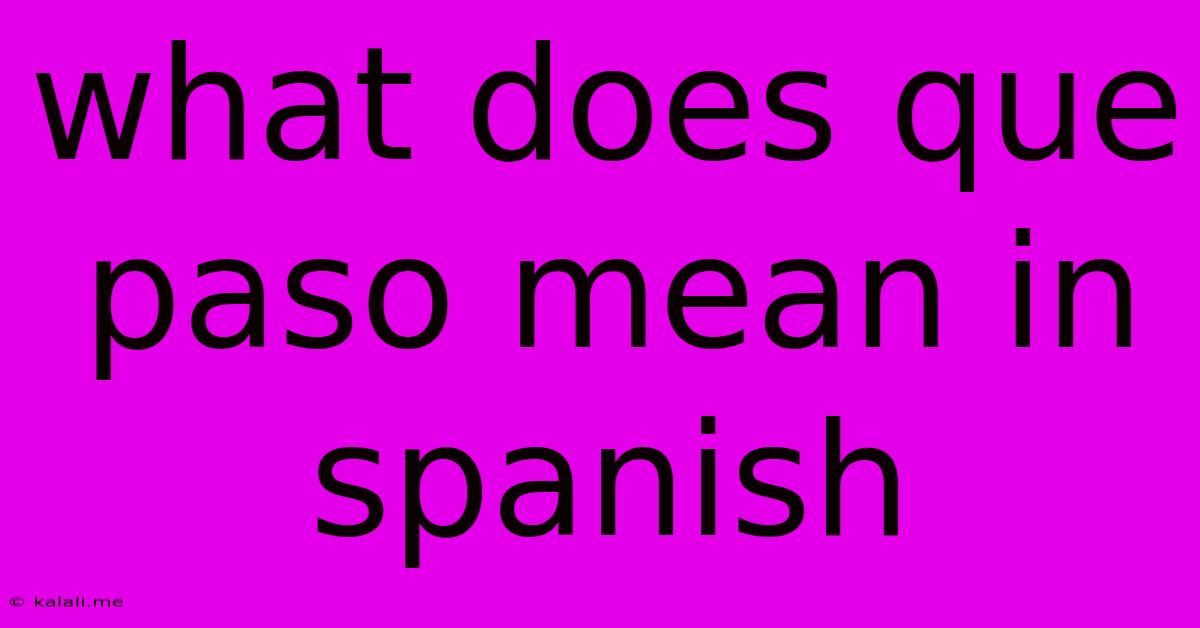What Does Que Paso Mean In Spanish
Kalali
May 28, 2025 · 3 min read

Table of Contents
What Does "Qué Paso" Mean in Spanish? A Comprehensive Guide
Meta Description: Learn the meaning and nuances of the common Spanish phrase "qué paso," including its various contexts and appropriate responses. Discover how to use it naturally in conversations.
The Spanish phrase "¿Qué pasó?" is a common expression used to ask "What happened?" or "What's up?" Understanding its nuances is key to effective communication in Spanish. This guide delves into its meaning, usage, and appropriate responses depending on the context.
Understanding the Literal and Figurative Meanings
Literally, "¿Qué pasó?" translates to "What happened?" It's used to inquire about a past event, often something unexpected or significant. Think of it as the Spanish equivalent of "What's the story?", "What went down?", or even "What's the tea?".
However, the meaning can be more casual. In informal settings, "¿Qué pasó?" can function similarly to the English "What's up?" or "What's going on?". It's a way to initiate a conversation and show interest in the other person's life, much like asking "How's it going?" but with a slightly more inquisitive tone.
Contextual Usage of "¿Qué Pasó?"
The context heavily influences the meaning and appropriate response.
-
Following an obvious event: If someone trips and falls, or a loud noise occurs, "¿Qué pasó?" directly asks about the immediate event. The response would likely be a description of what happened. For example: "¡Me caí!" (I fell!) or "¡Se rompió el vaso!" (The glass broke!).
-
Catching up with a friend: When meeting a friend after a while, "¿Qué pasó?" acts as a friendly greeting, inviting them to share news and updates. The response could be anything from recounting recent events to simply saying "Nada mucho" (Not much).
-
Expressing concern: If someone appears upset or distressed, "¿Qué pasó?" shows concern and empathy. The response might involve explaining the reason for their distress.
-
Informal settings: Among close friends and family, "¿Qué pasó?" can be used frequently as a casual greeting or conversational opener, even if nothing significant has happened.
How to Respond to "¿Qué Pasó?"
Your response depends entirely on the context and your relationship with the speaker.
-
Short and sweet: "Nada" (Nothing), "Todo bien" (Everything's good), "Bien, ¿y tú?" (Good, and you?), or "Normal" (Normal).
-
Detailed response: Share what happened, either a specific event or updates on your life. Remember to consider your audience and adjust your level of detail accordingly.
-
Expressing concern: If you sense the question implies concern, share the relevant details and possibly seek their advice or support.
Similar Phrases and Variations
While "¿Qué pasó?" is commonly used, there are similar expressions you might encounter:
-
¿Qué ha pasado?: This is a more formal version, often used in more polished settings.
-
¿Qué onda?: This is a more informal, Mexican Spanish variation, meaning something akin to "What's up?".
-
¿Qué tal?: This translates to "How's it going?" or "What's up?" and is a versatile greeting.
Mastering the nuances of "¿Qué pasó?" involves paying attention to context and tone. With practice, you'll confidently use this common phrase and navigate conversations with Spanish speakers seamlessly. Remember that the beauty of language lies in its ability to adapt to various social situations, and understanding these subtle differences elevates your communication skills.
Latest Posts
Latest Posts
-
Magic The Gathering Until End Of Turn
May 29, 2025
-
The Man In The High Castle Map
May 29, 2025
-
How To Unclog A Kitchen Sink Drain
May 29, 2025
-
Can You Transport A Hot Water Heater On Its Side
May 29, 2025
-
How To Change Profile Pic On Outlook
May 29, 2025
Related Post
Thank you for visiting our website which covers about What Does Que Paso Mean In Spanish . We hope the information provided has been useful to you. Feel free to contact us if you have any questions or need further assistance. See you next time and don't miss to bookmark.